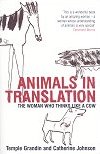I first came across the fascinating story of Temple Grandin in Oliver Sacks' An Anthropologist on Mars. Here we get more background and detail. I was initially attracted to this book by the title -- I know I don't think in words (it is sometimes very frustrating trying to translate thoughts into speech or text across this "impedance mismatch"), but I also know I don't actually think in pictures or diagrams -- because I can't draw them, either. However, what does it mean to think in pictures? Grandin gives a very vivid account of the way her mind works, and it is very different from anything I've heard of before: the vividness of the images, the ability to manipulated them, the degree of recall, the lack of generalisation.
The book is a collection of chapters describing different aspects of her life and her condition. The affect of autism on her perception, having to explicitly learn to respond to social cues, the squeeze machine, use and abuse of medication, designing slaughterhouses -- it's all here in a plain matter-of-fact style that is nevertheless deeply engrossing.
To start with, the factual descriptions lead you to think, well, okay, she has different perceptions, but maybe that's not so remarkable, just different. But towards the end, she describes the various panic attacks she suffered as a result of her condition, panic attacks that nearly made her into a housebound agoraphobic. The discussion again is remarkably matter-of-fact. It takes a little while to realise that she was having these debilitating attacks at the same time as she was building her highly successful career. That is a truly remarkable achievement.

